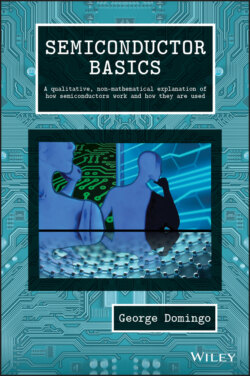Читать книгу Semiconductor Basics - George Domingo - Страница 11
Introduction
ОглавлениеA couple of years ago, I was asked to give a talk to the Rotary club in Terrassa, a city about 20 miles northwest of Barcelona. They asked me to divide the talk into three parts: 15 minutes biographical, 15 minutes on my technical work, and 15 minutes about NASA. The first and last 15 minutes of the talk went well, but the technical explanation about how infrared detectors work was disappointing. Yes, they did understand the uses and applications of infrared detectors, my technical work with the astronomical observatories of NASA, but the explanation on how infrared detectors work was not as clear and instructive as I had hoped. I was then and I am now convinced that any educated person can understand how semiconductor devices work. This talk two years ago was my motivation to start writing this book.
Semiconductors are the basis for almost all modern electronic devices. For many people semiconductors are a mysterious material that somehow has taken over modern electronics. In the same way that we understand the concept of god and creatures, but semi‐gods are confusing, most of us have an idea of what a conductor (electricity flows through it) and an insulator (it doesn’t) are, but what the heck is a semiconductor? Furthermore, the prevalent material used for fabricating semiconductors is pure silicon, the second most common element found on earth (28%) after oxygen (47%). Why not use aluminum, the next common element (8%), or strontium or some other exotic and more classy material? Why do we use semiconductors instead of conductors? Don’t we want electrons to move freely through our devices?
I attempt here to explain why and how semiconductors work in a form that any educated person can understand. Every chapter explains the subject in a qualitative way, with drawings, photographs, and figures, and very simple relationships (I hate to use the word “equations” here). At the end of most chapters I add appendices where I include some mathematical formulation with the relevant equations for those who would enjoy looking a little deeper into the subject. I do not try to proof these equations; my purpose is not formally present to you the physics of semiconductors (there are many excellent books that do that) but just to show what the results are. In this book you have to take these results on faith.
Unless you are very allergic to math, do not skip the appendices. There are interesting concepts that amplify the understanding of how semiconductors work. Don’t worry; there are no problems at the end of each chapter and no suggested quizzes.
First, I explain what a semiconductor is, the different types we use, and how they are different from conductors and insulators. Next, I explain the key devices that can be constructed using the semiconductor materials: diodes, passive element, and transistors. I talk about the integrated circuits, how we build them and the larger electronic components, and finally what can we expect in the future (Chapter 15). I interrupt the “theoretical” flow with chapters devoted to applications (Chapters 4, 7, and 9) that can be understood with just the concepts I have covered in the previous chapters.
This book can be read in different ways. If you are interested in understanding how transistors work, then you should read, in succession, Chapters 1, 2, 3, 5, and 8. You cannot skip any of them or read them in a different order unless, of course, you are already familiar with some of the previous topics. Chapter 6 explains the basic electrical components (resistors, capacitors, and inductors) which we need to understand how we build useful semiconductor circuits. I try to discuss some of the semiconductor applications as soon as I cover the relevant theory. Just by understanding the concept of energy levels and energy bands (Chapters 2 and 3) you can grasp how infrared detectors work (Chapter 4). You do not even need to know what resistors or capacitors are. Similarly, after Chapter 6 you can understand the different circuit applications we can fabricate with diodes (Chapter 7) and after Chapter 8 I explain how we use transistors (Chapter 9). The next chapters, integrated circuit fabrication (Chapter 10) and logic circuits (Chapter 11), can be read separately at any time, although knowing how a transistor works will help. Yes, I talk about semiconductor devices, but you do not need to know the physics of how they work to understand these two chapters.
Next, in Chapter 12, I explain large semiconductor components like multiplexers and memories. In Chapter 13, optoelectronics, I cover lasers and LEDs, and I end the book by discussing some simple concepts related to computer architectures and liquid crystal displays in Chapter 14. I speculate about the future in Chapter 15.
The objective of this book is to explain to the layman how semiconductors work and how they are used. I hope I have succeeded. If you have any comments or if you find errors, inconsistencies, unclear, incomplete or confusing figures or explanations, please let me know by emailing me at semiconductorbasics@hotmail.com.
I had a professor who taught me relativistic quantum mechanics, one of the hardest courses I ever took, who used to say, “Everything mathematical is trivial.” I agree with him, not 100%, but partially so. The truth is that we scare the hell out of young students by making them believe that mathematics, physics, and engineering are difficult. Wrong! Math is not difficult and physics, and all its derivatives, is fascinating.
So please enjoy.
George Domingo
March 2019
